Prior to DockerCon we had the opportunity to work with a large set of data collected by Bitnami (full disclosure: Bitnami is a RedMonk client). We previously took an in-depth look at current and future use of orchestration and CI tools. We have had an opportunity to revisit this data, and in this post we will look further into specific user types and their choice of container orchestration tools.
Survey Details
Bitnami collected this data by means of a user survey across their entire user base, and the survey garnered over 5,000 responses from a request sent to Bitnami’s e-mail distribution list of over 850K. With any data set of this nature, it is important to state that survey results strictly reflect the members of the Bitnami e-mail distribution list.
The data set covered areas including container usage and plans, orchestration tools where containers were being used, CI tools and database choices. For this post we will be focusing on the data around user roles and their choice or orchestration tools.
What makes this data very interesting is the number of companies who are actively using and evaluating containers versus those that are not. One of the issues with many surveys of container users is the automatic bias inherent in the selection criteria. While this data does not eliminate this bias, it does provide some interesting counter balances.
Population Groupings
For this analysis we break our population into five groupings:
- Companies between 2 and 50 employees
- Companies between 50 and 250 employees
- Companies between 250 and 1000 employees
- Companies with over 1000 employees
- Single Respondents
The percentage population breakdowns of these groupings is shown below, but in all groups other than single respondents developers are the largest single constituency.
For the purposes of this analysis we have removed students from the main analysis and include a small note on their responses at the end of this post.
Orchestration Tool Choices
Breaking out orchestration tool choices across roles and organisation size we see the following
Companies Using Container from 2 to 50 Employees
Companies Using Containers from 51 to 250 Employees
Companies Using Containers from 251 to 100 Employees
Companies Using Containers with 1000 or more Employees
Individual Participants
The most striking fact that comes through all of this data is the number of participants who are not using any orchestration tools at all, most notably in small and very large companies. As we noted in our pervious analysis a large amount of the population was planning to use containers, so this may account for part of this number.
Another significant contributory factor is just how early in the IT adoption life cycle we are for containers. There is huge interest, and many successful enterprise deployments, but it is still just the tip of the iceberg for longer term adoption.
Kubernetes v’s Swarm
As we noted previously Docker Swarm has a much stronger presence in the orchestration tools space within this survey population than many commentators believed, and this survey is prior to the direct integration of swarm into Docker 1.12. Kubernetes has a slight lead in all categories, but other than a small lead among midsize companies (250 to 1000 employees) there is no strong trend in either direction.
We do, however, expect this battle to heat up immensely over the coming months. Both Docker and Kubernetes are putting an immense amount of focus into improving the user experience of both platforms. This will drive further adoption.
Students
We briefly looked at the student responses around orchestration tools. In the main there are no surprises here, most are not using any orchestration, nor would you really expect them too, and those that are are pretty evenly split between Swarm and Kubernetes.
Disclaimers: Bitnami and Docker are current RedMonk clients.
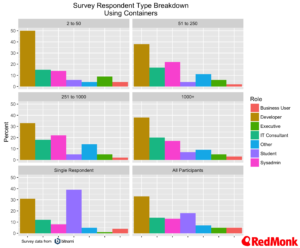
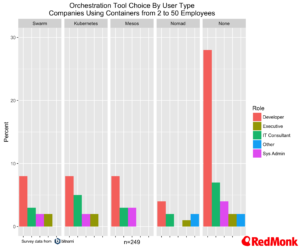

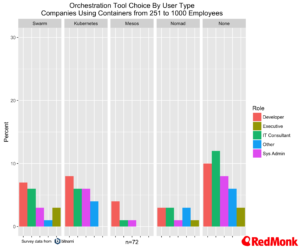
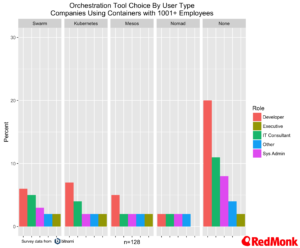
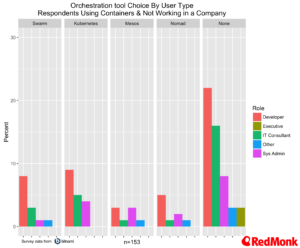
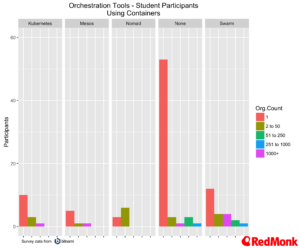
No Comments